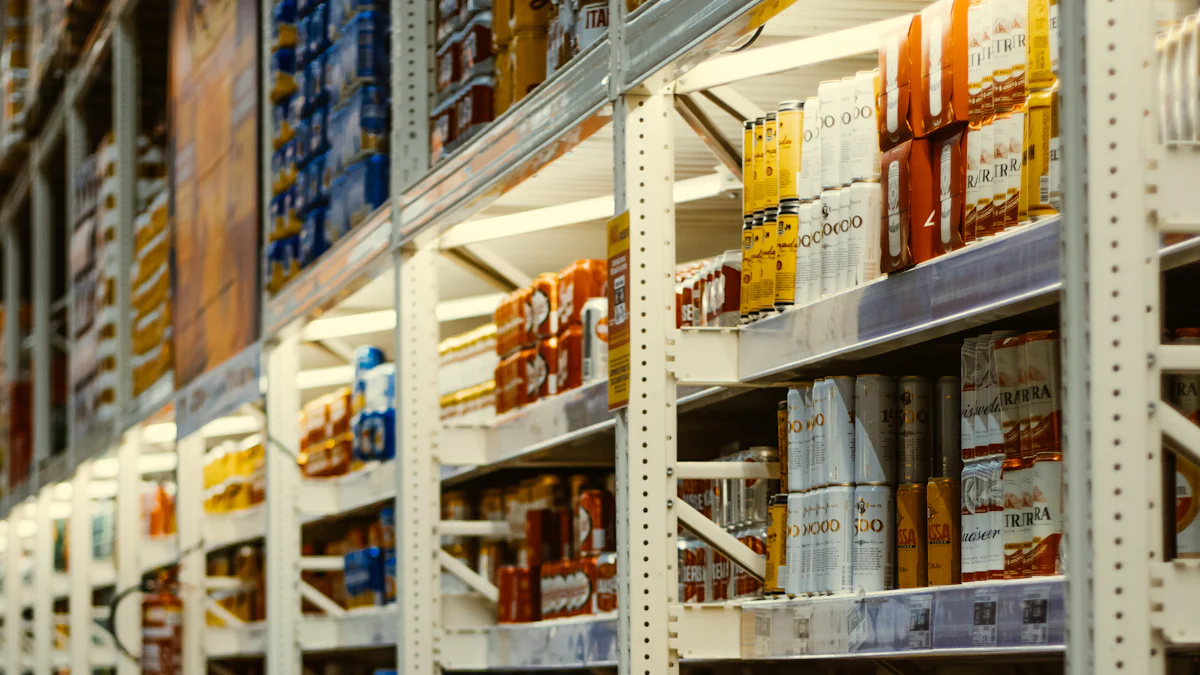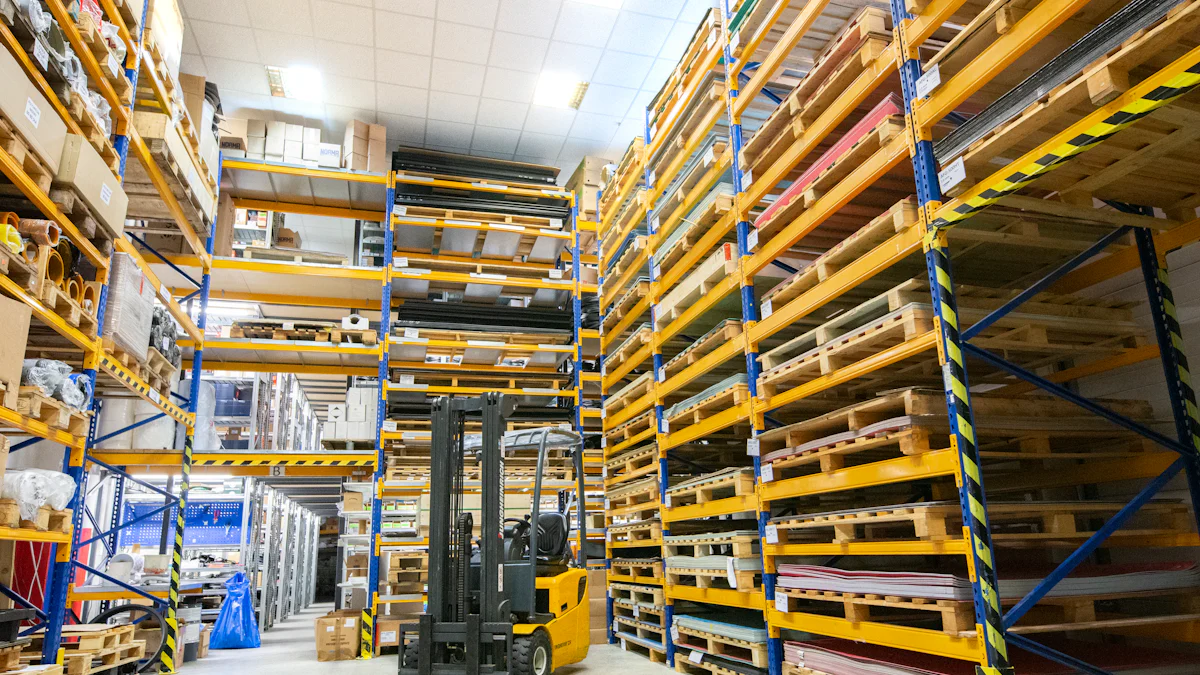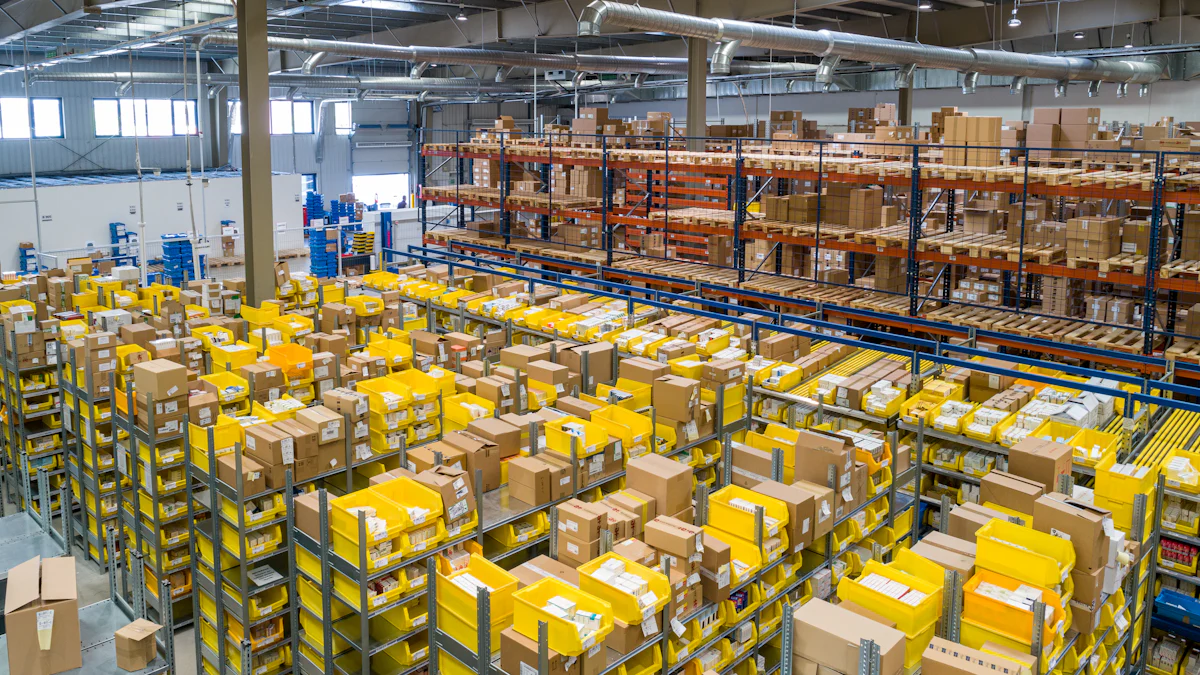Comprehensive Guide to Modern Warehousing Solutions

Warehousing plays a pivotal role in the supply chain by storing goods for further distribution or selling. Efficient warehousing solutions ensure smooth operations, reducing delays and costs. The evolution of warehousing practices has seen significant advancements. Modern warehouses now utilize automation, IoT technology, and green design to enhance efficiency. Over 75% of warehouses have adopted automation, reflecting this trend. The average warehouse space utilization reached 85.6% in 2022, showcasing the importance of optimizing storage strategies.
The Role of Technology in Modern Warehousing

Automation and Robotics
Automated Storage and Retrieval Systems (AS/RS)
Automated Storage and Retrieval Systems (AS/RS) represent a significant advancement in warehousing solutions. These systems use computer-controlled methods to automatically place and retrieve loads from defined storage locations. AS/RS enhances efficiency by reducing manual labor, minimizing errors, and optimizing space utilization. This technology supports high-density storage, which maximizes the use of available warehouse space.
Warehouse Robots
Warehouse robots have revolutionized modern warehousing solutions. These robots perform various tasks such as picking, packing, sorting, and transporting goods within the warehouse. They improve operational efficiency by working alongside human workers or autonomously. Robots reduce the time required for order fulfillment and increase accuracy in inventory management.
Warehouse Management Systems (WMS)
Features of WMS
Warehouse Management Systems (WMS) are integral to modern warehousing solutions. Key features include real-time inventory tracking, automated order processing, labor management, and integration with other technologies like robotics and IoT devices. WMS provides visibility into inventory levels across multiple locations, ensuring accurate stock control.
Benefits of Implementing WMS
Implementing a WMS offers numerous benefits for warehousing solutions:
Real-time visibility into inventory levels
Reduced operational costs through automation
Enhanced accuracy in order fulfillment
Improved coordination between different warehouse areas
Increased productivity due to optimized workflows
Internet of Things (IoT) in Warehousing
IoT Devices and Sensors
The Internet of Things (IoT) has become a cornerstone of modern warehousing solutions. IoT devices and sensors monitor various aspects of warehouse operations such as temperature, humidity, lighting conditions, and equipment status. These devices provide real-time data that helps in maintaining optimal storage conditions for different types of products.
Real-time Data and Analytics
Real-time data collection through IoT devices enables advanced analytics in warehousing solutions. Analytics tools process this data to provide insights into inventory levels, order patterns, and operational bottlenecks. This information allows warehouse managers to make informed decisions that enhance efficiency and reduce costs.
Sustainable Warehousing Practices
Energy-efficient Warehousing
Renewable Energy Sources
Modern warehouses increasingly adopt renewable energy sources to reduce carbon footprints. Solar panels on warehouse roofs generate electricity, cutting utility costs and lowering emissions. Wind turbines also provide a sustainable energy option for large facilities. Geothermal systems offer an efficient way to heat and cool warehouses, utilizing the earth's natural thermal properties.
Energy-saving Technologies
Energy-saving technologies play a crucial role in sustainable warehousing. LED lighting systems consume less power and last longer than traditional bulbs. Motion sensors control lighting and HVAC systems, ensuring energy use only when necessary. Cool-roof systems reflect sunlight, reducing cooling needs during hot months. Skylights maximize natural light, decreasing dependence on artificial lighting.
Waste Reduction Strategies
Recycling Programs
Recycling programs help warehouses manage waste effectively. Facilities sort materials like cardboard, plastic, metal, and paper for recycling instead of disposal. Some warehouses implement closed-loop recycling systems, where packaging materials return to suppliers for reuse. This practice minimizes landfill waste and supports a circular economy.
Sustainable Packaging
Sustainable packaging reduces environmental impact by using eco-friendly materials. Biodegradable packaging decomposes naturally without harming ecosystems. Recyclable materials like cardboard and certain plastics ensure that packaging can be reused or repurposed after initial use. Minimalist packaging designs reduce material usage while still protecting products during transit.
"Implementing energy-efficient practices can significantly lower utility bills, reduce carbon emissions, comply with regulations, and provide a competitive advantage."
Warehouses adopting these strategies not only benefit the environment but also achieve cost savings and operational efficiency improvements.
Warehouse Design and Layout

Space Optimization
Vertical Storage Solutions
Vertical storage solutions maximize warehouse space by utilizing the height of the facility. Implementing vertical racking systems allows for more inventory storage without expanding the warehouse footprint. These systems include pallet racks, mezzanines, and automated vertical lift modules (VLMs). Pallet racks store goods on multiple levels, increasing storage density. Mezzanines create additional floor space above existing operations, providing room for offices or extra storage. VLMs use automated technology to retrieve items from high shelves, reducing manual labor and improving efficiency.
Efficient Aisle Design
Efficient aisle design enhances warehouse productivity by optimizing movement paths for workers and equipment. Narrow aisles increase storage capacity but require specialized equipment like narrow-aisle forklifts. Wide aisles accommodate standard forklifts and allow for easier maneuverability. Cross-aisles provide shortcuts across the warehouse, reducing travel time for picking and replenishment tasks. Clear signage and floor markings guide workers, minimizing errors and enhancing safety.
Safety and Ergonomics
Safety Protocols
Safety protocols ensure a secure working environment in warehouses. Regular safety audits identify potential hazards such as obstructed pathways or malfunctioning equipment. Training programs educate employees on proper lifting techniques, equipment operation, and emergency procedures. Personal protective equipment (PPE) like helmets, gloves, and safety shoes protect workers from injuries. Fire safety measures include installing extinguishers, smoke detectors, and sprinkler systems throughout the facility.
Ergonomic Equipment
Ergonomic equipment reduces physical strain on warehouse workers, enhancing comfort and productivity. Adjustable workstations allow employees to modify their workspace height to suit their needs. Lift-assist devices help with heavy lifting tasks, preventing musculoskeletal injuries. Anti-fatigue mats provide cushioning for workers who stand for long periods, reducing foot discomfort. Ergonomically designed tools such as pallet jacks with easy-grip handles improve handling efficiency while minimizing physical effort.
"Optimizing warehouse layout through effective space utilization strategies can lead to increased efficiency, reduced costs, and a more profitable business."
Implementing these design principles not only improves operational efficiency but also ensures a safer working environment for all employees.
Future Trends in Warehousing
Artificial Intelligence and Machine Learning
Predictive Analytics
Predictive analytics has become a game-changer in modern warehousing. Advanced algorithms analyze historical data to forecast future demand accurately. This capability allows warehouses to optimize inventory levels, reducing both overstock and stockouts. By predicting order patterns, warehouses can allocate resources more efficiently, ensuring timely order fulfillment.
"Predictive analytics, together with artificial intelligence (AI), can be very effective for recommending optimized inventory levels, replenishing inventory, increasing operational efficiency, and optimizing warehouses." — Industry Experts
Warehouses leveraging predictive analytics experience improved operational efficiency. Real-time insights into inventory trends enable proactive decision-making. This approach minimizes disruptions and enhances overall productivity.
AI-driven Inventory Management
Artificial Intelligence (AI) revolutionizes inventory management by automating complex tasks. AI systems monitor stock levels continuously and trigger automatic reordering when supplies run low. This automation reduces human error and ensures consistent stock availability.
AI-driven systems also enhance warehouse layout optimization. Machine learning algorithms analyze product movement patterns to suggest optimal storage locations. This strategy minimizes travel time for picking tasks, boosting worker productivity.
"Advanced analytics and machine learning allow for predictive modeling, enabling better demand forecasting and optimal resource allocation." — Industry Experts
Implementing AI-driven solutions leads to significant cost savings. Automated processes reduce labor costs while improving accuracy in inventory management.
Blockchain Technology
Enhancing Transparency
Blockchain technology offers unparalleled transparency in supply chain operations. Each transaction gets recorded on an immutable ledger accessible to all stakeholders. This transparency ensures that every step of the supply chain is visible and verifiable.
"Blockchain technology could provide unparalleled transparency in supply chains, ensuring the ethical and sustainable sourcing of materials." — Industry Experts
Enhanced transparency builds trust among partners and customers alike. It enables quick identification of issues such as delays or discrepancies in shipments.
Improving Security
Security remains a critical concern in warehousing operations. Blockchain technology addresses this issue by providing a secure platform for recording transactions. The decentralized nature of blockchain makes it resistant to tampering or hacking attempts.
Each transaction undergoes encryption before being added to the blockchain ledger. This security measure protects sensitive information from unauthorized access.
"With these trends shaping the future of warehousing, companies will have the opportunity to enhance their competitive edge, improve customer satisfaction, and drive overall business growth." — Industry Experts
Adopting blockchain technology enhances data integrity within warehouse operations. Secure transactions ensure accurate record-keeping while safeguarding valuable information from potential threats.
Recap of Key Points
Modern warehousing solutions have revolutionized the industry. Technologies like AS/RS, WMS, and IoT devices enhance efficiency and accuracy. Sustainable practices reduce environmental impact while optimizing costs. Advanced design principles improve space utilization and safety.
The Importance of Adopting Modern Solutions
Adopting modern solutions remains crucial for operational efficiency and sustainability. Advanced technologies optimize space utilization, reduce energy consumption, and enhance overall productivity. Businesses must stay updated on the latest trends to remain competitive.
Final Thoughts on the Future of Warehousing
Future trends in warehousing include AI-driven inventory management and blockchain technology. These innovations promise enhanced transparency, security, and efficiency. Embracing these advancements will ensure businesses stay ahead in an evolving landscape.
"Staying updated on the latest trends in warehouse management is crucial for businesses to remain competitive and efficient."
See Also
Boosting Warehouse Efficiency with Robotics Technology
Understanding Robotic Automation for Warehouse Efficiency
The Importance of Warehouse Automation for Businesses
Maximizing High-Tech Manufacturing with Automated Warehousing
Achieving Success in High-Tech Manufacturing through Lean Logistics
